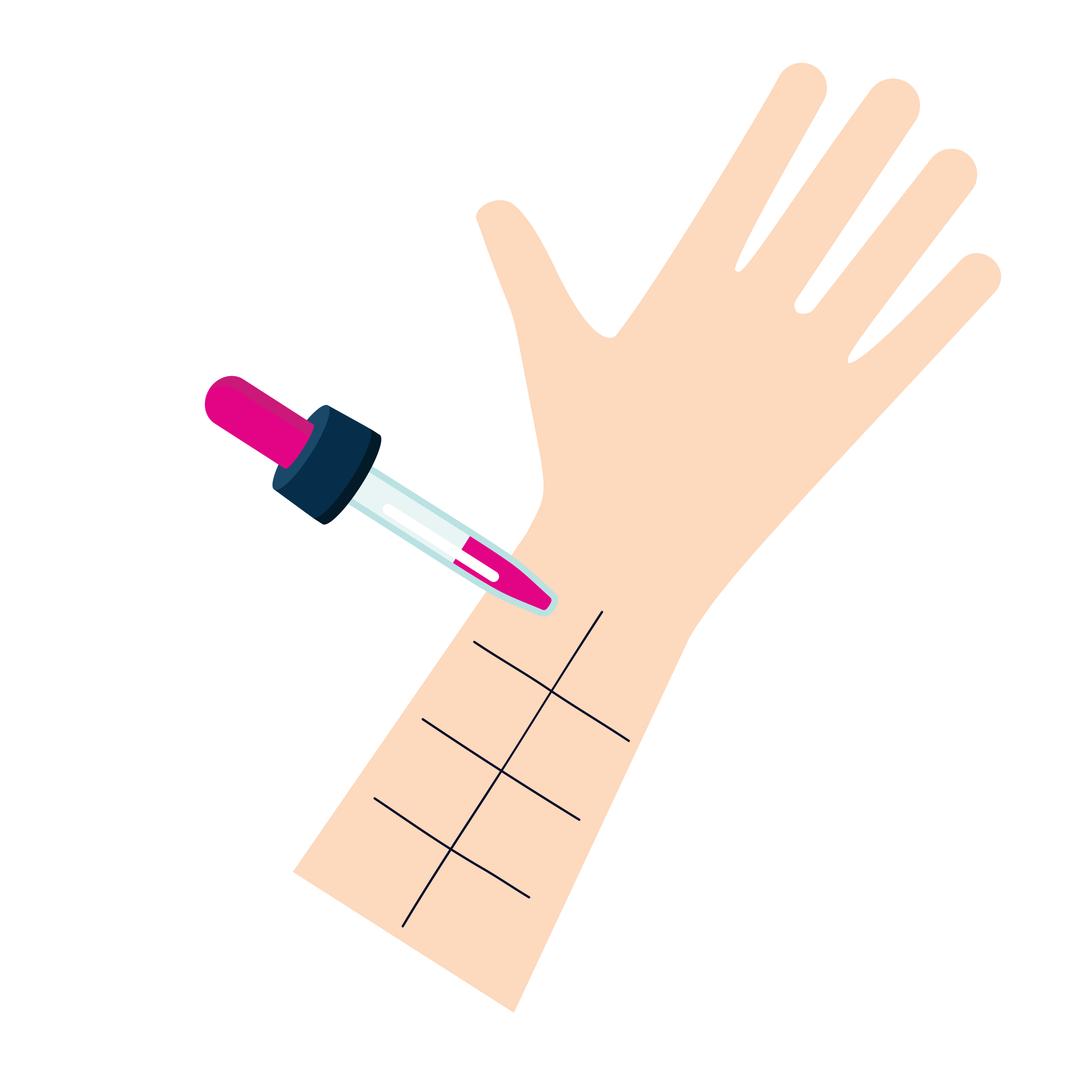Allergy tests are used to help get a diagnosis or to see if your allergies have changed. Tests are only part of the process and your clinical history (what has happened and the signs or symptoms) is also very important.
Your GP may send you for tests before you see a specialist. These tests are to see if your symptoms are caused by an allergy or by something else. The results may help your GP decide which specialist you will be referred to.
If you are referred to a specialist, they may do more tests.
Allergy tests should be evidence-based. This means that there is scientific evidence that a test is reliable and appropriate.
The most common test used for allergy is to check to see whether you have immunoglobulin E (IgE) antibodies to a substance in the environment (allergen) such as food, grasses, pet dander and mould. This can be checked with a blood test, called a serum specific IgE (ssIgE) test, or skin prick test. If you have had anaphylaxis, you will need to wait about 6 weeks after the event before having a skin prick test or blood test. This is because of changes in your body that have happened due to the severe allergic reaction.

A positive skin prick test or blood test does not necessarily mean that a person is allergic to an allergen; it just means that they are sensitive to it or “sensitised.” For example, if someone has a positive skin prick test to egg but can eat egg with no reaction, they are sensitised to egg, but not allergic to egg. This is why testing should not be done unless the clinical history suggests there is an allergy.
Types of allergy testing

Skin prick test
A skin prick test checks to see if the immune cells in the skin react when an allergen comes into contact with these cells. This is done by putting a small drop of fluid that contains an allergen, such as food, grass, mould, onto the skin and then pricking or scratching the skin very lightly. During a skin prick test, the area can become itchy. It is important not to scratch as this can mean the results cannot be seen clearly and the test may need to be repeated. After the results have been recorded you may wish to take antihistamine.
Read more
Testing for lots of different allergens that are not related to your clinical history can make finding out what you are allergic to harder. For example, if you are eating peanut regularly and are not having any signs of allergy after eating peanut, a skin prick test to peanut will not be helpful.
Skin prick testing is usually done by an allergy specialist but it can also be done by a GP, paediatrician, nurse practitioner or nurse who has done training in skin prick testing and has the correct equipment available to them.
With most skin prick testing you should not have antihistamine (eg. Zyrtec®, Telfast®, Claratyne®) for at least three days before the appointment. Check with the clinic as some doctors prefer you avoid antihistamines for longer than three days.
Taking antihistamines, before a skin prick test can affect the results of the test. If you take antihistamines before your appointment, you may not be able to have a skin prick test done on the same day.
The results are available in about 15-20 minutes. They are often done during your allergy specialist appointment and the doctor will talk to you about the results while you are with them.
The results of skin prick tests can vary depending on many things, such as the age of the person, where on the body the test is done, and the technique of the person doing the tests. Skin prick tests should be ordered by someone who understands allergies, which allergens to test, what the results mean, and can give you a clear management plan when you get the results.

Blood tests
Different types of blood tests measure different things. The most commonly used blood test for allergy is called a serum specific IgE (ssIgE or sIgE) test, also known as a RAST. RAST is an older type of allergy blood test but the name is often used when talking about this type of allergy blood test.
Read more
There are other blood tests that are used by allergy specialists to check for less common allergic conditions but sometimes there is no blood test available. Your doctor or nurse practitioner will decide if a blood test may be helpful once they have talked to you about your allergic condition (taken a clinical history).
Blood tests can be taken at your GP practice, in a hospital, at a blood collection centre or pathology lab.

Testing for allergies (ssIgE)
If a doctor or nurse practitioner thinks a substance from the environment may be causing your allergies they can order a ssIgE test for that allergen (substance).
Food panel tests are not recommended. Panel tests are when lots of different allergens are checked. Testing for lots of different allergens that are not related to your clinical history can make finding answers harder. For example, if you are eating sesame regularly and are not having any signs of an allergic reaction after eating sesame, a blood test to check for IgE to sesame will not be helpful.
There are also blood tests which can show which part of the allergen protein your body is allergic to (component). The most commonly used component blood test is for peanut allergy. There is ongoing research into different component testing but these tests are not available to the general public.
You will need to wait to get the results of a blood test so you may have the test before your appointment or find out the results afterwards. Ask your doctor if you need to make another appointment to get the test results or if they will tell you over the phone or in a letter.
Once you have the results your doctor should update you on any changes to how you should manage your allergic condition.
| Skin prick test | ssIgE blood test | |
| Where can the test be done? | Hospital allergy clinic, allergy specialist clinic, GPs who have done training and have the equipment needed. | • GP practice, hospital, a blood collection centre or pathology lab. • More available in regional and remote locations. |
| What can be tested? | • House dust mites • Animal dander • Mould • Pollen • Foods • Fresh foods | • House dust mites • Animal dander • Mould • Pollen • Foods • Insect venom • Some drugs (medication) |
| Will it be uncomfortable? | • Less painful than a blood test. • Need a skin prick for each allergen being tested. • Skin can be itchy while waiting for the results. | • Requires needle for blood test. • Can be taken if blood test needed for other health condition |
| What does Medicare cover? | Medicare covers many allergens at once (there may still be an out-of-pocket cost) | • Medicare covers 4 ssIgE to different allergen in one test. • Cost for additional allergen. |
| What are the risks? | Very rare risk of anaphylaxis | As for any blood test: • Fainting • Bruising • Discomfort at site |
| Can I take antihistamines before the test? | Usually not | Yes |
| Can I do the test if skin is affected by eczema? | Can not be done on skin affected by eczema | Yes |
| When will I get my results? | 20-30 minutes | Within a few hours or up to a few days |
Oral food challenge
An oral (by mouth) food challenge may be ordered for:
- Checking if a suspected food is the cause of an allergic reaction.
- A person who has had a positive skin prick test but has not eaten the food before.
- A person who is thought to have outgrown their food allergy.
- A person who is allergic to see if a food can be eaten in another form, for example a baked food.
Read more
An oral food challenge is usually ordered by an allergy specialist and is often done by a nurse who is trained to do it under the supervision of the specialist. It may be done in either a public hospital, private hospital or private specialist rooms.
An oral food challenge involves the person eating the food allergen under the care of a health professional following strict guidelines.
Most people will not have an allergic reaction while they are having an oral food challenge. Some people will have an allergic reaction, and this may be a severe allergic reaction (anaphylaxis). This is why an oral food challenge is always done where medical help is available.
The health professional will talk to you about the results and give you the information you need.
For more information see Food allergy testing – oral food challenges.
Breathing tests
Some people with allergic conditions may need to have breathing tests to see how well they are breathing. Depending on your symptoms, breathing tests which could be ordered include:
- Spirometry
- Peak flow
- Chest X-ray
- Oxygen saturation measurement.
Some of these tests can be done in the GP or specialist rooms. X-rays are done by a medical imaging service.
Drug (medication) allergy tests
Drug allergy testing is more specialised than some other allergy tests and is done by an allergy specialist or specialist hospital team. Types of tests for drug allergy include:
- Skin tests
- Drug challenges
- Blood tests.
These tests are usually done in a hospital allergy clinic under strict protocols.
Other tests
There are other tests that are used for specific allergic conditions, such as:
- A person with exercise induced anaphylaxis may have a medically supervised exercise challenge.
- People with eosinophilic oesophagitis (EoE) usually need an endoscope. This is where a special camera is used to look at their oesophagus (tube that connects the mouth with the stomach).
Speak with your GP if you need more information about a test. They will be able to let you know whether the test is proven to give correct information about your condition.
Skin prick tests explained

Dr Brynn Wainstein is a paediatric immunologist and allergist. He is a staff specialist at Sydney Children’s Hospital and in private practice in Bondi Junction, Sydney.
Unproven tests
Unproven tests are tests which are not evidence-based. This means there is no research to show the test works and is reliable. The results and information you receive from an unproven test may be incorrect or misleading. Unproven tests can lead to a wrong diagnosis. These tests can cost a lot of money, increase anxiety, and lead to unnecessarily avoiding foods, which in children, can cause problems with nutrition and affect growth. Avoiding a food you are not allergic to could also increase your chances of developing an allergy to that food in future1-4. Unproven tests are often advertised through social media and not recommended by your GP.
Unproven or ‘non-evidence-based’ tests include:
- Cytotoxic food testing
- Kinesiology
- Hair analysis
- Vega testing
- Electrodermal testing
- Pulse testing
- Reflexology
- Bioresonance
- Bryan’s or Alcat tests
- VoiceBio
- Allergy elimination techniques and immunoglobulin G (IgG) to foods
If you are offered a test, it is important to ask:
- What proof is there that this works?
- Has any evidence been published in medical journals?
- What are the risks and benefits?
- Are there any side effects?
- If I decide not to have this test, what will happen to me?
- How much is the test going to cost?
- Has my doctor suggested this type of test?
- What qualifications does the person recommending the test have?
- How is it possible that one test can detect so many different problems?
You can read more about evidence-based versus non-evidence-based allergy tests and treatments on the Australasian Society of Clinical Immunology and Allergy (ASCIA) website.
References:
1. Du Toit, G., et al. (2015). “Randomized Trial of Peanut Consumption in Infants at Risk for Peanut Allergy.” New England Journal of Medicine, 372, 803-813. This study presents evidence on peanut exposure reducing allergy development.
2. Position Statement by ASCIA on Allergy Prevention (2016): Australasian Society of Clinical Immunology and Allergy (ASCIA). “ASCIA Guidelines – Infant Feeding and Allergy Prevention.”
3. Koplin, JJ, Osborne, NJ, Wake, M, et al. (2010). “Can early introduction of egg prevent egg allergy in infants? A population-based study.” Journal of Allergy and Clinical Immunology, 126,807-813.
4. Katz, Y, Rajuan, N, Goldberg, MR, et al. (2010). “Early exposure to cow’s milk protein is protective against IgE-mediated cow’s milk protein allergy.” Journal of Allergy and Clinical Immunology,126,77-82.e1.
Understanding allergy care
Learn about allergy care, seeing an allergy specialist, the Australian health system, treatment options and more.
Developed as part of the Shared Care for Allergy Project, in collaboration with the National Allergy Council through funding from the Australian Government, Department of Health, Disability and Ageing.

